Recession Resistant REITs Priced at Attractive Valuations
It has long been held that owning homes and apartments has been one of the better inflation-sensitive assets for managing through periods of higher inflation. And due to the supply shortage of affordable shelter brought on by the pandemic, the housing market in many cities with strong migration trends has not seen prices come down much despite all the reports suggesting otherwise.
According to the St. Louis Federal Reserve, the median sales price of houses sold in the United States peaked in the fourth quarter of 2022 at $479,500, and has retreated by 8.9% to $436,800 by the end of March 31, 2023. This may be true in a number of fly-over states, but I know folks looking for homes in Westchester County, New York, Sarasota, Florida and Richmond, Virginia where prices are steadily increasing in select neighborhoods, even as the Fed conducts its 10th consecutive rate hike.

Some housing markets that went parabolic are seeing some give back. At the end of March, Redfin reported that the median sale price for homes in red-hot Austin, Texas fell 16.4% year over year, with the average days on the market being 59, representing a meaningful jump of 33 days for a listed home. Zillow reports Austin had more than 10,000 units available last month, compared to last year, when only 7,700 units were available. “Buyers in pandemic-era hotspots like in Austin and Phoenix are seeing their markets return faster to normal,” said Orphe Divounguy, a senior economist with Zillow.
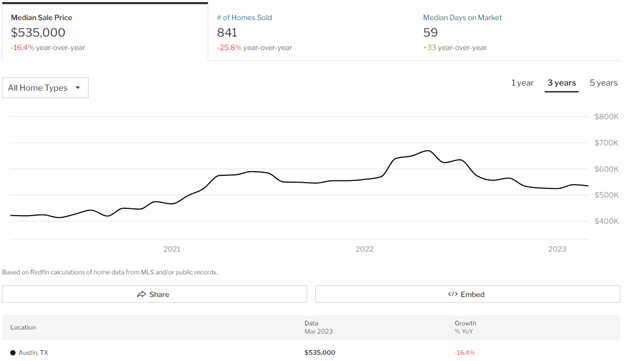
With the Fed seemingly done with rate hikes given the fragility of the banking industry, and all the inverted balance sheets that are coming to light, one could argue that home prices may not retreat that much more if mortgage rates are plateauing and supply is still tight across most markets. Heck, most of those reading this column remember back in the late 1980s, when mortgages finally fell below double-digit-percentages.
I remember when my wife and I purchased our first home in 1987 in San Diego, when the rate on a 30-year fixed rate loan fell to 9.875%. We celebrated, considering when we moved to San Diego in 1985, 30-year rates were pushing 15%. And somehow, home prices held their ground, because “America’s Finest City,” as it is fondly called, was enjoying strong net migration of new residents.
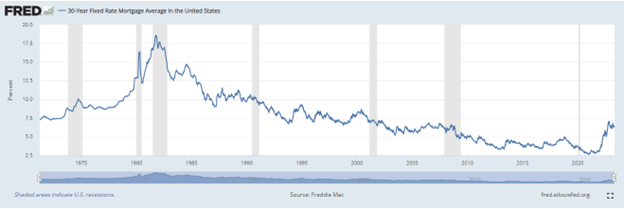
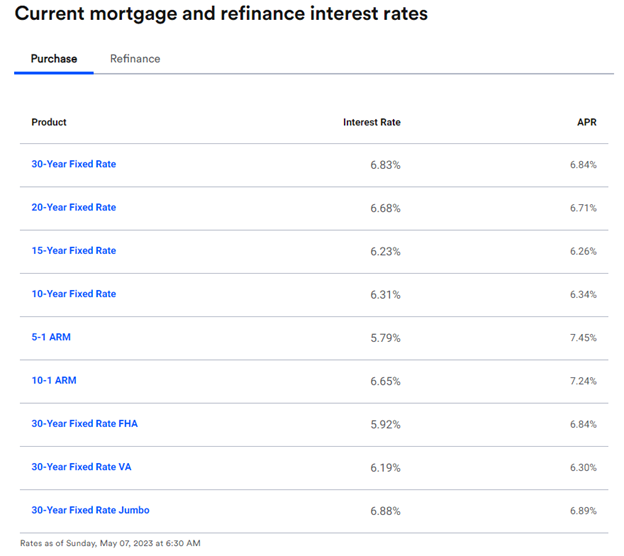
Source: Bankrate.com
With the scales now tipping in favor of the housing market finding a bottom in a market that is tight on supply, it might prove to be a good time to consider residential REITS. Per a recent March 8, 2023 CNN report, “The United States is not building enough homes to account for the number of people setting up their own households. As a result, there is a sizable shortage of new homes after more than a decade of under-building relative to population growth, according to a new analysis from Realtor.com released Wednesday.
“The gap between single-family home constructions and household formations grew to 6.5 million homes between 2012 and 2022. However, this figure overstates the housing shortage, since new multi-family homes offer options both to buyers and renters. If multi-family construction is included — which is predominantly rental units — this gap is cut to 2.3 million homes.”
Last week’s employment data showed a big downward revision in the prior months reported. Despite April nonfarm payrolls increasing by 253,000 (Briefing.com consensus 180,000), the three-month average for total nonfarm payrolls fell to 222,000 from 295,000. March nonfarm payrolls revised to 165,000 from 236,000, and February nonfarm payrolls revised to 248,000 from 326,000. With more slack now entering the job market and home prices looking to level out where workers want optionality in relocating, it would seem the rental market would benefit in this unfolding landscape.
If so, then multi-family residential REITs, single-family residential REITs and self-storage REITs might make for a good investment proposition, as most of these classes of REITS have undergone sharp valuation compression that coincided with the steep correction in that of commercial office real estate where vacancy rates are very elevated. Granted, increases in rental income where offset by rising operating costs brought about by inflation, but landlords should start to see the pendulum swing back in their favor as inflation trends lower going forward.
When I look at the iShares Residential and Multisector Real Estate ETF (REZ), it provides a nice snapshot of essential income and growth properties that are more recession resistant than other classes of REITs. The top 10 holdings, of which there are 39 in total, make up just over 63% of total assets ($648 million), and consist of self-storage, healthcare, apartment/townhome/house rental and retirement communities. (I have no position in these stocks.)
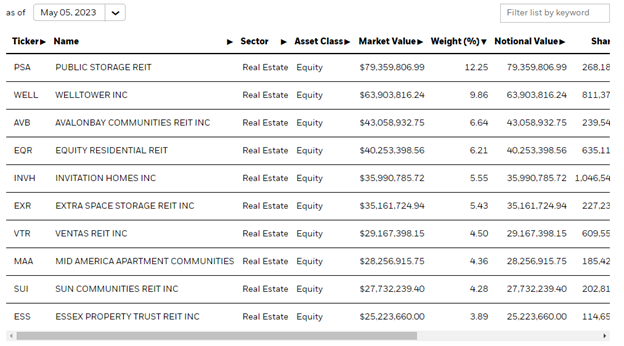
Source: ishares.com
For those that want a technical take, shares of REZ are down 27% from their 2022 high and have been building a multi-month base while paying out a dividend yield of 3.25%. Not the most attractive yield, but a stable payout that will likely withstand any further slowing of the economy.
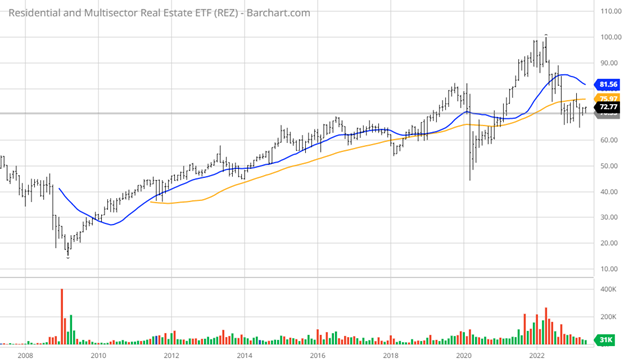
Other classes of REITs that are more vulnerable to a recession include office, industrial, retail, lodging, resort, leisure, convention, commodity and advertising. At this time, the data supports slower growth ahead for the U.S. economy, as the lag effect of 10 rate hikes works through the system. As such, it is no surprise that the REIT sector, as a whole, is underperforming. However, economically defensive REITs trading at steep discounts are starting to look attractive for those investors that want to carve out which REITs stand to weather best the risk of recession.
IMPORTANT ANNOUNCEMENT: We are having our Eagle Virtual Trading Event on Tuesday, May 16. If you haven’t signed up for this yet, there’s still time. Just click here now to sign up for free. Believe me, you won’t want to miss this online event — as we bring together all of Eagle’s investment experts at the same time to reveal the Second Half Outlook: 7 Ways to Beat the Market. Reserve your seat now by clicking here.
P.S. Come join our Eagle colleagues on an incredible cruise! We set sail on Dec. 4 for 16 days, embarking on a memorable journey that combines fascinating history, vibrant culture and picturesque scenery. Enjoy seminars on the days we are cruising from one destination to another, as well as dinners with members of the Eagle team. Just some of the places we’ll visit are Mexico, Belize, Panama, Ecuador and more! Click here now for all the details.

